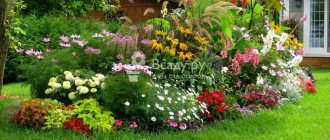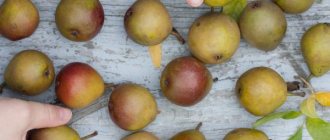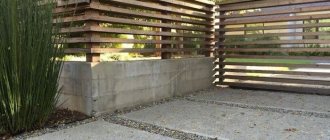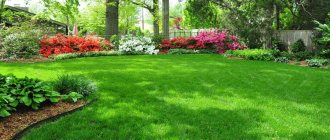Flower beds and flower beds decorate all summer cottages. In addition to aesthetic appeal, they create an atmosphere of harmony and comfort. Do you have a garden that you want to give an attractive appearance, but not the state of a green area? We will offer you varieties of flowers, which, planted in the tree trunks of apple, cherry, pine, thuja and various other trees, will give your territory a beautiful appearance.
We design flower beds under garden and coniferous trees
In addition, varieties of certain flowers will help enrich the soil with nutrients. These are quite unpretentious flowers that grow well in the shade. When choosing plants, you need to pay attention to the shape of their leaves, as they can be used to make a flower arrangement truly unique and original.
Spring primroses
Primrose
One of the first heralds of spring (beautiful primrose, planted in the garden)
Primrose is one of the first plants to bloom in early spring. Today there are many varieties and hybrid species of these flowers. They feel great next to any plants. Frost-resistant and shade-loving, easy-to-care primrose has long become a favorite of landscape designers. By combining different varieties when planting, you can admire the flowering of primroses from April to August and even September. It is grown from seeds, leaf cuttings and dividing the bush. It has medicinal properties (for diseases of the upper respiratory tract).
What to do before planting a flower bed
First of all, pay attention to the composition of the soil and select plants based on this. They must be resistant to temperature changes and lack of moisture.
Using a small hoe or spatula, clear the top layer of soil from small roots, stones and debris. Determine the depth of the roots by removing some soil from the surface. You also need to find out how dense and branched the tree’s root system is. If the bayonet of the shovel hits the rhizome every time, no matter where you start digging, it means it’s better to look for another place for the flower garden.
By planting different flowers, you can create a variety of flower arrangements.
If there are no other trees nearby, you can try to spread the roots, forming small “pockets” for future flowers. Sometimes partial root pruning is required, but remember that the root system should not be pruned by more than 10%. Pruning the roots will also entail pruning the crown - cut it in proportion to how much the rhizome has shrunk.
Cover the bottom of the dug holes (planting holes) with non-woven material or a thin mesh. This will help prevent them from being penetrated by tree roots and will somewhat curb their growth.
An important factor when arranging a flower garden is proper drainage. To prevent water from stagnating in the flower garden, fill the bottom of the planting holes with a mixture of fine gravel, pebbles and sand. Fill the prepared holes halfway with fertile soil mixture recommended for planting flowers, and mix it one-third with soil extracted from the holes. Plant the flowers so that the root collar rises 2-3 cm above the ground. Compact the soil and water generously.
Muscari, crocuses and other “spring” bulbs
Floral beauty (muscari)
Bulbous plants are the first flowers of spring. Having planted them under the trees, they will bloom immediately after the snow melts and will become the first decoration of your garden, before the first leaves bloom on the trees.
The snow has barely melted, but the first delicate bulbous flowers are blooming in our garden
For perennial bulbous flowers, no special conditions need to be created. They are unpretentious to the soil. But so that the tree trunk circle is not empty after they bloom, we recommend planting other flowers with different flowering periods nearby.
Bright and beautiful spring crocuses under an apple tree. Plant bulbs of different colors under the trees and get this result
How to arrange a flower garden under a tree: design of tree trunk circles
Ecology of consumption. Estate: Many owners of suburban areas dream of having a garden surrounded by greenery and fragrant flowers...
Many owners of suburban areas dream of having a garden surrounded by greenery and fragrant flowers. But to successfully implement the idea and create a picturesque artistic image, you have to use every centimeter of the earth.
As the practice of experienced gardeners shows, lush and elegant flower beds can be arranged not only in open areas, but also tree trunks can be used for these purposes.
Principles for arranging tree trunk flower beds
It is rare to find a dacha or suburban area where fruit trees do not grow. But these plants with spreading crowns and well-branched root systems take up a lot of space on the site. How to rationally use the area under the trees to make the garden more elegant and attractive, but without harming the plants?
Young seedlings need careful care. Their tree trunk circles must be left open, as they are needed for fertilizing and watering. The opinion that tree roots grow straight down into the ground is erroneous. Some of them are located in the upper layers of the soil, going only 40-50 cm deep. This point should be taken into account when choosing a place for a flower bed so that the roots of neighboring plants do not harm each other in the struggle for life-giving moisture and nutrients.
For example: birch, walnut and horse chestnut have a powerful superficial root system. Any plants in the trunk circles of these trees feel uncomfortable. But apple, hawthorn and rowan have a taproot system. They happily grow ferns, ornamental grasses and flowers under their crown, allowing them to turn bare trunk circles into picturesque flower beds.
When creating flower beds around trees, you should adhere to the same principles as when arranging flower beds in open areas. The only difference is to carefully select plants that will be comfortable in conditions of lack of moisture and light, and also carefully (with minimal damage to the tree’s root system) cultivate the soil before planting flowers.
What should you think about first?
When thinking about where to arrange a flower garden, it is important to imagine what the plants planted under the tree will look like in a couple of years. When choosing flowers, you should take into account the characteristics of the soil composition on which they prefer to grow, their resistance to temperature changes, and lack of moisture.
At the site of the future flower garden, using a small shovel, we clear the soil from small roots, debris and stones that penetrate the soil. The roots of the trees should not be touched. But you should determine their density in advance by digging with a shovel in several places of the future flower garden, going as deep as possible.
If every time the shovel hits an extensive network of roots, it is better to look for another place for the flowerbed. A possible option is to dig in the roots, in which the “interfering” branches are moved apart, creating small “pockets” for planting flowers.
If when arranging a flower garden you cannot do without partial pruning of the tree roots, then when performing work you should be guided by the principle that you can “cut off” no more than 10 percent of the entire root system .
After trimming the root, you will have to shorten the crown of the tree, reducing it by the same amount. The bottom of the dug holes, intended for arranging planting holes for flower bed plants, is lined with non-woven material or a fine mesh. This will prevent the penetration and intertwining of plant roots and will somewhat slow down their growth.
Drainage is an important point when arranging a flower garden. To prevent water from stagnating in the flower garden, we line the bottom of the “pockets” with a ten-centimeter “cushion” of gravel, pebbles or sand.
We fill the prepared holes halfway with fertile soil mixture, a third of which is the soil dug out when creating the planting holes. We plant plants in the holes so that the root collar of each is 2-3 cm above ground level. We compact the soil and water it.
What plants to choose for compositions?
Most caris-flowering perennials prefer sunny, fertile areas. But placing a flower garden under a tree is impossible to achieve such conditions. Even if the tree has a transparent, sparse crown, only part of the sunlight will fall on the flowers planted under it. Therefore, when choosing plants, preference should be given to shade-tolerant and shade-loving flowers . Dwarf varieties of conifers, bulbous plants and annuals are ideal for decorating a flower garden under a tree .
hosta, lily of the valley, anemone, foxglove, ivy, primrose, and lysimachia will feel comfortable .
By decorating the tree trunk circle, you can solve two problems at once: achieve a decorative effect and protect fruit trees from attacks by harmful insects . Nasturtium can protect cherry and apple trees from apple worm and blood aphids. Marigolds and daisies perfectly repel aphids and nematodes, and lilies of the valley protect stone fruits from fruit rot.
In early spring, bare tree branches will not block the penetration of light into the flowerbed, giving the primroses the opportunity to please the eye even before the leaves bloom on the crown.
Ready-made schemes for arranging flower beds
There are many options for creating spectacular plant compositions on the tree trunk. These can be multi-level round flower beds, the outer edge of which is decorated with low-growing plants, and the inner space is filled with taller flowers.
When decorating tree trunk circles placed along a building or fence, which are visible only from one side, semicircular and asymmetrical flower beds are more suitable.
When arranging multi-tiered compositions, it should be taken into account that the trunk circle of fruit trees can be filled to a height of no more than 10-12 cm. Filling the root collar of a tree with soil can lead to rotting of the trunk.
Option 1 - spring kaleidoscope
1. Lesser periwinkle (Vinca minor). 2. Cyclamen narcissus (Narcissus cyclamineus). 3. Chionodoxa luciliae. 4. Spring crocus (Crocus vernus). 5. Tulip (Tulip 'Burgundy Lace'). 6. Corydalis bulbosa (Corydalis bulbosa).
To arrange such a flower garden in the fall, you should clear the tree trunk area around the tree of small stones and roots of weeds. You can enrich the soil by adding compost and organic fertilizers.
Bulbous plants look impressive in small groups: they sparkle in the sunlight like scatterings of multi-colored kaleidoscope glass.
Daffodils, crocuses and tulips are planted in groups, placing them at a distance of 15-20 cm from each other.
In the foreground of the flower garden, small tubers of corydalis are planted - a herbaceous plant that got its name due to the bizarre shape of the flower.
The empty spaces between the bulbous meadows are filled with periwinkle bushes creeping along the ground.
To protect the bulbs from frost and provide them with conditions for growth and full flowering in early spring, it is better to cover them with spruce branches or foliage before the cold snap.
Option 2 - contrast of primroses
1. Siberian blueberry (Scilla sibirica). 2. Narcissus (Narcissus 'Tahiti').
It is not at all necessary to give the flower bed an even round shape. A worthy frame for contrasting flowering meadows is decorative tiles, with which the flower garden can be given any shape.
Daffodil bulbs and scillas are also planted in the fall, placing them in small groups around the tree trunk. After the daffodils fade, in their place there remain cute herbaceous “bushes” collected from elongated smooth leaves that remain decorative until mid-summer.
Option 3 - solar paints
1. Winter spring grass (Eranthis hiemalis). 2. Crocus Tommasini (Crocus tommasinianus). 3. Crocus (Crocus 'Ruby Giant').
Early spring eratis, decorated with tiny golden-yellow flowers, is most decorative only in the sun. Fortunately, in early spring the tree crowns do not provide dense shade, giving these unusually beautiful herbaceous plants the opportunity to express themselves in all their glory.
When arranging a flower garden, first think through the design of the composition. Crocus corms are planted along the outlined contours, and winter spring rhizomes are used as a background. After the spring flowering of crocuses, faded flowers are not removed, thereby allowing the plants to reproduce using seeds.
Slideshow with examples from gardeners
SUBSCRIBE to OUR YouTube channel Ekonet.ru, which allows you to watch online, download free videos from YouTube about human health and rejuvenation. Love for others and for yourself, as a feeling of high vibrations, is an important factor in healing - econet.ru
Please LIKE and share with your FRIENDS! https://www.youtube.com/channel/UCXd71u0w04qcwk32c8kY2BA/videos
Subscribe - https://www.facebook.com/econet.ru/
With the help of flowers, even empty spaces under a tree can be turned into picturesque and pleasant corners of the garden. Spectacular flower arrangements framing the tree trunks will decorate the garden with delicate colors and fill it with charm. published
PS And remember, just by changing your consumption, we are changing the world together! © econet
Join us on Facebook, VKontakte, Odnoklassniki
Fern
Fern - its shape resembles a “palm tree”, a very unpretentious plant that will delight you with its lush form until autumn.
You can increasingly find this plant in summer cottages. The mysterious beauty of the fern has given rise to many rumors about its mystical powers, but despite this, the fern has taken root well in summer cottages and decorates more than one garden with its foliage. It tolerates shade well, but is demanding on moisture.
Plant ferns along the paths - it will turn out beautiful and attractive
Geranium macrorhizomatous
macrorrhizum is a hardy geranium, a perennial plant with saucer-shaped flowers in pink, purple and blue hues and lobed leaves. Geraniums are easy to grow and will bloom for months in the shade, providing a long season of pollen and nectar for a range of pollinators (and especially bees).
Large-rhizome geranium (Geranium macrorrhizum). © Mozarta
The most popular variety 'Ingwersen's Variety' is especially beautiful. It blooms with pale pink flowers on dark red stems from June to October. This geranium is ideal for use as a ground cover under trees. It is easy to grow and tolerates most conditions except waterlogged soil.
This plant can cope with such difficult conditions as dry shade under the canopy of trees. But large-rhizome geranium is suitable for both sun and shade. It is recommended to regularly remove spent flowers to prolong flowering.
Spreading boron
Spreading pine pine (Milium effusum) is an interesting option for those who would like to see cereals under the trees. Spreading pine has light green hollow stems, each of which bears about four alternate linear leaves. The blades of flexible sheets reach 16 mm. During the flowering period, each stem ends in a panicle of spikelets, which has a pyramidal-oblong shape; in appearance it is airy and drooping. Particularly interesting in decorative floriculture is the 'Aureum' variety, which is distinguished by its greenish-yellow foliage color.
Spreading boron (Milium effusum). © RootGarden
Boron is suitable for light (sandy), medium (loamy) and heavy (clayey) soils, prefers well-drained soils, without stagnant moisture. Acidic, neutral, and alkaline soils are suitable for it. Can grow in full shade (in forest thickets) or partial shade, tolerates drought well. It is a cool season grass and grows quickly in the spring. Quite thermophilic, but winters well in the Moscow region.
Vertical flower bed from a pallet
In small gardens and loggias there is not much space, so you need to carefully plan the surface and choose the best solutions that will help you place more details while taking up less space. A vertical flower bed will allow you to plant many plants in a small area.
Old tires can be used to create raised beds - you just need to connect a few tires together. Old car tires filled with soil and flowers are probably the most common type of flower bed in dachas. Tires can be painted in bright colors, applied with an ornament or an interesting pattern, and hung on the wall.
Almost any of the presented materials can be used in several ways. The only limitation is the imagination of the owners of personal plots. It is important not to “overdo it” in such ingenuity and preserve the main task of the fence (fencing): to limit the surface of the flowerbed.
It often happens that for the sake of beauty, practicality is neglected and the decorative fence quickly becomes unusable. Therefore, it is better to use reliable, time-tested methods. A rim with uneven edges can create a risk of injury; unstable materials will quickly fail.
The result will be additional, unnecessary work, wasted time. Still, creating a flower bed is not like building a house, and anyone who has the desire can do it with their own hands, using these simple tips.
Creeping tenacious
Creeping creeper (Ajuga reptans) is a fast-growing herbaceous perennial ground cover plant (the name of the species speaks for itself - “creeping”). Although it blooms with very attractive blue-violet inflorescences, it is mainly valued for its foliage.
Creeping tenacious (Ajuga reptans). © Universität Göttingen
Tenacious is excellent for filling large shady areas where lawns are difficult to grow, but can work well on banks or slopes, planted around trees and shrubs. The plant forms a dense mat that suppresses weeds.
The survivor is so resilient that it can even grow under black walnut (Juglans nigra), which produces a chemical that interferes with the growth of other plants. However, you should be careful when planting the grasshopper near lawns because it can quickly spread to lawn grass.
The creeping tenacious feels good in bright sun or in partially shaded places. When growing varietal plants, it is worth keeping in mind that foliage color will be most vibrant when the plant receives at least three to four hours of sunlight per day. Depending on the variety, the tenacious can have tricolor variegated foliage, or leaves of a chocolate brown or purple hue, as well as variegated ones.
Pachysandra apex
Pachysandra terminalis is an evergreen perennial whose foliage does not die off in winter, but only turns slightly yellow. This groundcover produces delicate white flowers in spring but is grown primarily for its persistent, leathery, dark green leaves. This species has dark green leaves, but there are also variegated varieties with a light border along the edges of the leaf blade.
Pachysandra terminalis
This plant is best grown in partial to full shade, in acidic soil enriched with compost. Pachysandra apex is a very resilient perennial. Its “tolerance” allows it to solve four main problems familiar to gardeners: pests, drought, shade, heavy clay soils.
This plant is an effective ground cover for weed control as it spreads to form a dense cover that inhibits weed growth. But pachysandra's hardiness can be a double-edged sword. To prevent it from becoming an aggressor, the tree trunk circle must be fenced off with border tape.
Heuchera
Heuchera is a perennial ornamental foliage plant with hundreds of varieties, distinguished by very bright leaves and small bell-shaped flowers that appear in spring or early summer on tall stems. Nectar-rich flowers attract butterflies.
Heuchera. © KL Gaffney
The leaves are round, lobed, pubescent, evergreen or semi-evergreen, depending on the climate. In addition to the traditional coral flowers with green leaves, new varieties have leaves in shades of purple, pink, lime green, gold, etc., often with distinctive venation and ruffled edges.
Heucheras like moderate humidity and thrive in partial shade. Keep in mind that plants planted in damp shade may be susceptible to fungal diseases if there is excess moisture. If your plants have problems, it is best to transplant them to a drier location.
Heucheras are short-lived perennials, so it is advisable to divide the bushes every three to five years in early spring or fall.











